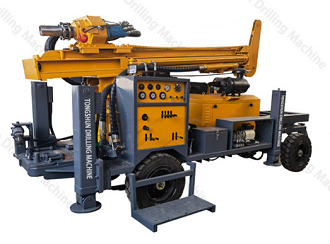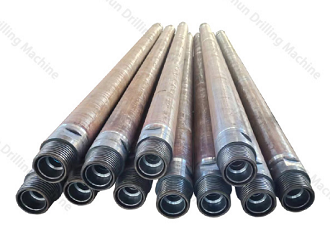Water wells play a crucial role in accessing clean and reliable water sources, particularly in remote or rural areas where traditional water supply systems may be lacking. Crawler mounted water well drilling rigs offer an efficient and versatile solution for drilling wells in various terrains and conditions. In this comprehensive guide, we'll delve into the working principles of crawler mounted water well drilling, providing insights into the technology, process, and benefits of this innovative drilling method.
Crawler mounted water well drilling rigs are powerful machines designed to penetrate the earth's surface and create boreholes for water extraction. Unlike traditional truck-mounted rigs, crawler-mounted rigs are equipped with tracks or crawlers, providing enhanced mobility and maneuverability across challenging terrain, including rocky landscapes, steep slopes, and soft soils.
The drill mast is the vertical support structure of the rig, housing the drilling mechanism, hoisting system, and control panel. It provides stability and support during drilling operations, allowing for precise positioning and alignment of the drilling equipment.
Crawler mounted rigs are typically powered by diesel engines or hydraulic systems, providing the necessary power and torque to drive the drilling process. The power source also operates auxiliary systems such as the hydraulic pumps, compressors, and winches.
The track system consists of robust tracks or crawlers that propel the rig across various terrain types, including rough terrain, mud, sand, and gravel. The tracks distribute the rig's weight evenly, minimizing ground pressure and ensuring traction and stability during operation.
Before commencing drilling operations, the drilling site is carefully selected and prepared to ensure safe and efficient drilling. Site preparation may involve clearing vegetation, leveling the ground, and securing the rig in position using stabilizing jacks or outriggers.
2.1. Formation Analysis
The drilling team conducts a thorough analysis of the geological formation and subsurface conditions to determine the optimal drilling parameters, such as drilling depth, diameter, and drilling method.
2.2. Drill Bit Selection
Based on the formation analysis, the appropriate drill bit is selected to penetrate the specific geological strata encountered during drilling. Common drill bit types include tricone bits, PDC (Polycrystalline Diamond Compact) bits, and drag bits, each designed for different rock formations and drilling conditions.
2.3. Rotary Drilling
Crawler mounted rigs employ rotary drilling techniques, where the drill bit rotates to create a borehole by fracturing and pulverizing the rock formation. Drilling fluid, typically water or mud, is pumped down the drill pipe to lubricate the bit, carry cuttings to the surface, and stabilize the borehole walls.
Once the desired depth is reached, steel casing pipes are installed into the borehole to prevent collapse and contamination of the well. The casing is secured in place using cement or grout, ensuring a sealed and stable well structure. Final steps include well development, testing, and installation of pumping equipment to extract water from the well.
Crawler-mounted water well drilling rigs are widely used in various industries and applications, including:
Water Well Drilling: Crawler-mounted rigs are commonly used for drilling water wells in rural, remote, and inaccessible areas where traditional drilling methods are impractical.
Geotechnical Exploration: These rigs are utilized for soil sampling, geotechnical testing, and environmental monitoring in construction, mining, and infrastructure projects.
Mineral Exploration: Crawler-mounted rigs play a crucial role in mineral exploration, allowing geologists to collect rock samples and assess mineral deposits in remote and challenging terrain.
The advantages of crawler-mounted water well drilling rigs include:
Mobility: Crawler tracks enable rigs to traverse rough terrain, steep slopes, and narrow access roads with ease, providing access to remote drilling sites.
Stability: Hydraulic stabilizers and low center of gravity ensure stability and safety during drilling operations, minimizing the risk of accidents and equipment damage.
Efficiency: Powerful hydraulic systems and advanced drilling technology enable rigs to penetrate various geological formations quickly and efficiently, reducing drilling time and costs.
Crawler mounted water well drilling rigs offer a versatile and efficient solution for accessing clean and reliable water sources in diverse geographical settings. By understanding the working principles of these rigs, including their components, drilling process, and site preparation, drilling contractors and water resource professionals can optimize drilling operations and ensure the success of water well projects.
For more information on crawler mounted water well drilling rigs and drilling equipment solutions, contact us today. As a leading supplier of innovative drilling technologies, we're committed to supporting your water well drilling needs.


Copyright © Jinzhou City TongShun Drilling Machine Co.,Ltd. All Rights Reserved Sitemap | Powered by 